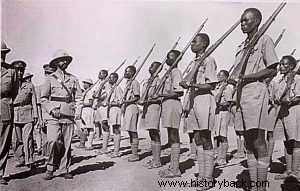
The "Kebur Zambania" (Honor Guard) was the body guard of the Ethiopian Emperor Haile Selassie. This body was derived from the modern gendarmerie, the Xabanga, formed by Haile Selassie with the help of Swiss soldiers.
This gendarmerie formed the core of the guard that began to be formed in the early 1930s under the supervision of Belgian officers. The garrison was equipped with Mannlincher rifles . It originally had the strength of a battalion of infantry, a company of cavalry and a detachment of military music.
Gradually the garrison came to line up six battalions. Each battalion had one machine gun company and three rifle companies. The officers were Ethiopians, some of them graduates of the French military academy at Saint-Syr. At the same time, Haile Selassie founded a military academy in Addis Ababa in 1935. The goal of the Ethiopian emperor was to modernize the entire Ethiopian regular forces. But the Italian attack caught up with him.
The Battle of Maicheu
On October 3, 1935, the Italians invaded Ethiopian territory, through Eritrea, without declaring war. Under Marshal de Bono the Italians fielded 125,000 men, of which 25,000 were natives from Eritrea.
Due to de Bono's little progress, Mussolini replaced him with Badoglio in December. Under new command, the Italians resumed their advance towards the Ethiopian capital Addis Ababa, overthrowing the Ethiopian forces with the use of aviation, tanks, and chemical gases.
On March 1, 1936, with the Italians closing in on the capital, Haile Selassie personally took command. The Ethiopians had four corps of which the most combat-worthy was the brigade of the guard. A squadron with 12 75mm guns, some 37mm anti-aircraft guns and a few 81mm Brand mortars was also allocated to the garrison.
Haile Selassie attempted to join the Azebu Gala clan who were considered the best horsemen in the region. They initially agreed but then backed out. Badolio had a total of seven divisions, four Italian, three colonial from Eritrea, with a total strength of approximately 80,000 men.
Haile Selassie had only 31,000 men. Nevertheless, he decided to attack. Anyway, even if he had waited for the Italian attack, the result would not have been different. So he decided to risk trying to surprise the opponent. But the Italians knew the intentions of their opponents from intercepted signals.
Haile Selassie's intention was to attack on 24 March before the Italians could gather all their forces. But he was dramatically delayed and when he finally attacked, on March 31, the Italians were waiting for his men in organized positions. Badolio had placed the 5th Mountaineer Division (MA) "Pusteria" and the 1st and 2nd Eritrean Divisions (ME) in the front line.
In the second echelon, he assigned the 26th Infantry Division (MP) "Asieta", the 30th MP "Sabaumba", the Blackcoat Division (MM) "January 3rd" and the "March 23rd" MM.
Attack
In the early hours of March 31, Saint George's Day for Coptic Christian Ethiopians , the attack was launched. Saint George is the patron saint of the Ethiopian army. The first attack was carried out by 9,000 Ethiopians in three phalanxes against the 5th MA and succeeded in penetrating the first Italian position. But the elite alpinists held on.
After this Haile Selassie unleashed 15,000 of his men against the 1st and 2nd ME and despite heavy losses they managed to break through again. But everything changed when the Italian Air Force intervened. Unperturbed, the Italian pilots bombed and machine-gunned the defenseless Ethiopians. The Italians again dropped chemicals to stop the advance of their brave opponents.
Haile Selassie then decided to throw his strongest formation, the garrison, into battle. The six guard battalions charged with discipline and courage against the 2nd ME and attempted to break the left flank. For three hours the Ethiopian guards fought with incredible courage, ignoring the losses.
An entire battalion of the 2nd ME was wiped out by the guards. Only the immense superiority of the Italians in media managed to stop them. The whole of the Italian artillery turned against them and iron prevailed over courage.
After that the battle was definitely lost for the Ethiopians. Nevertheless, Haile Selassie launched a last general, this time, attack but was repulsed. At that moment the Azebu Gala betrayed the emperor and attacked the Ethiopians.
Italian losses exceeded 1,200 dead and wounded. The losses of the Ethiopians were overwhelmingly heavier, reaching, according to some sources, 11,000 men. However, they suffered the greatest losses in the retreat phase.
It was the end. Haile Selassie's defeated army retreated in disorder pursued by the Gallas and Italian planes. The garrison took up rearguard duties and again fought bravely. Unmolested, the Italians now advanced towards the capital, taking control of Addis Ababa on May 1.
However, the resistance did not stop until the liberation of the country in 1940-41 by the British. It is worth noting that the officers and soldiers of the guard formed the first nuclei of resistance against the Italian invaders.
In total the war against Ethiopia cost the Italians 54,000 casualties in the seven months it lasted. Their losses during the occupation of the country (1936-40) exceeded 154,000 men. Ethiopian casualties in soldiers and civilians from 1935 to 1940 exceeded 750,000 souls.

Haile Selassie inspects recruits in 1934.
